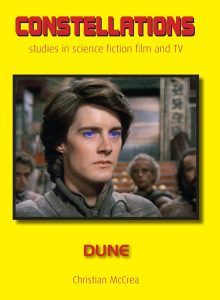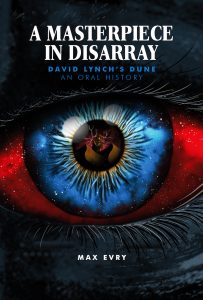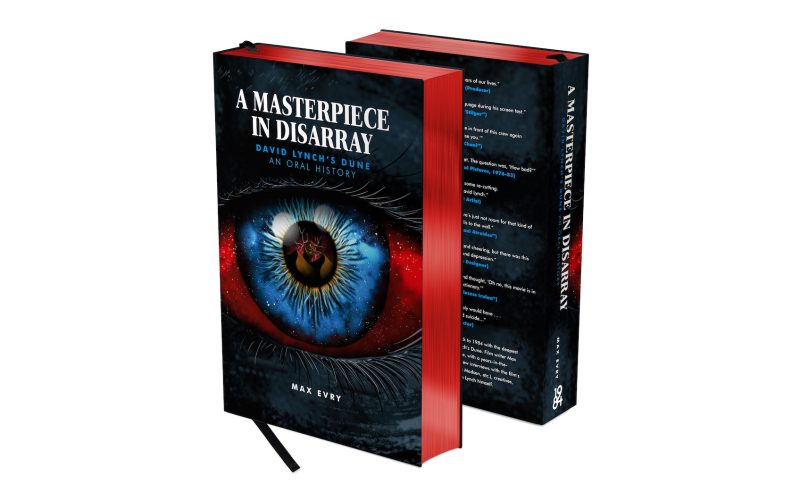It’s got scandals, hot takes, regrets, and reflections. It’s got serious musings alongside funny anecdotes. It’s all about the infamous Dune film adaptation by David Lynch, and whatever you think of the original film (or extended version, or fan edits…) you won’t want to miss this engaging story about this fateful production.
In Max Evry’s new book, A Masterpiece in Disarray: David Lynch’s Dune. An Oral History, he provides a behind-the-scenes look at the 1984 film adaptation of Frank Herbert’s science fiction book, Dune (1965), with the benefit of nearly four decades of time for reflection. As an experienced film journalist, he conducted a wide range of interviews with members of the original cast and crew to bring to life the troubled story of this production. There’s a bit of everything, including juicy pieces of gossip, frank discussions that didn’t make it into the press at the time, and thoughtful reflections about what happened and what might have been.
Readers will feel for actors such as Molly Wryn, who successfully wrote to Lynch to get a part, but whose character Harah was ultimately all but cut out of the theatrical film version. They’ll get the inside scoop on things like what happened to the original special effects company that left partway through production, or what were some of the crafty antics of producer Dino de Laurentiis.
Evry’s book gives tantalizing insights into the truth behind various rumors, and how many of the cast and crew were impacted by their time spent on the production. It rounds out the bits and pieces of information scattered around about this infamous film and humanizes the figures involved at every level, from the 9-year-old boy playing one of Jamis’ sons, Danny Corkill, all the way to the director himself, David Lynch.
The book is divided into four sections: Pre-Production, Production, Post-Production and Release, and Legacy. Each section discusses background and general information before diving into interviews/oral histories organized by topic. What this means is that snippets from interviews with different people are grouped together, rather than having each person’s interview included as a separate thing (except for Lynch’s). This method brings together interview material in a logical fashion and has the benefit of highlighting inconsistencies between different people’s memories of what happened. It creates a liveliness to the material and a sense of historical flow, guided by Evry’s commentary and scene-setting. There are also photographs of the production, merchandise, and parties in the middle of the book.
Pre-Production Chapter
In Pre-Production, Evry offers an overview of previous adaptation attempts, even beyond the ones that are traditionally discussed. He mentions that a writer’s strike in the 1970s caused a delay to an unmade adaptation of Dune, not unlike the current delay for Denis Villeneuve’s Dune: Part Two. There are background details on the lives of Herbert and Lynch, and an extensive discussion of the casting decisions made. This prompts thoughts about what might have been, had, say, Tom Cruise or Val Kilmer been cast as Paul Atreides, or Helena Bonham Carter been cast as Princess Irulan. The oral history section offers more interesting details about what crew members thought about the book and how they approached the adaptation. For instance, costumer designer Bob Ringwood didn’t think the books were very good nor did he like Herbert, and he pushed for the sexualization of the Baron, based on a collection of S&M books.
Production Chapter
The Production chapter summarizes the problems of shooting the film in Mexico City, alongside discussions of other aspects such as the costumes and how actors experienced the process of filming. It also includes fun tidbits such as how many bugs they encountered during night shoots, and how Patrick Stewart didn’t know who Sting was and had what sounds like an embarrassing conversation trying to figure out what kind of band he played in! Cast and crew give a sense of what it was like working with Lynch and how some of the special effects were created. There’s no doubt of Lynch’s interest in the weird and grotesque—for example, for the Guild Navigator, he wanted a more afterbirth look, so the crew found some gelatinous stuff that Lynch thought was perfect for the Navigator’s head. The interviews even bring into question some of the ethics around filming, such as extras being paid in shoes or not at all, or on the flip side, making up elaborate costumes just to keep supporting the employment of local women. For those interested in which people had read the book and what they thought of it, there’s a part on who had a good grasp on the material and who struggled with the language.
Post-Production and Release Chapter
In Post-Production and Release, Evry delves into the special effects work and the much-discussed cutting process that turned the four-hour-plus first cut into the final 2-hour-17-minute theatrical version. For instance, whereas there had originally been a more faithful scene of Paul taking the Water of Life in the sietch, this and other connected scenes were taken out and a new scene shot that has Paul seeming to command the sandworms out in the open desert. Evry explains why there wasn’t an official director’s cut, what changes were made to the opening and voiceovers, and how the film got delayed so it was no longer a summer release. This chapter also explores the making of the soundtrack by Toto, the marketing campaign and toy development, critical reviews of the film at the time of release, box office results, the extended edition, and some of the differences between the film and the book. The oral history section goes into detail about the disagreements about the special effects from different people’s perspectives, how the soundtrack was conceived, and what people from Universal think about their role in helping or harming the film’s success back in the ‘80s. People’s memories of the cutting process help explain why it was such a painful ending to the production process for Lynch. But there’s also the sense that it was marketed in the wrong way and hardly had a chance to succeed as a more complex work than other science fiction films.
Legacy Chapter
The Legacy chapter summarizes the aftermath of the film and other projects of the De Laurentiis family and Lynch, then moves on to the oral history section, which looks at the impact of the film on various members of the cast and crew and their perception of what happened to Lynch after Dune. There is interesting insight into what could have been in the extended edition, had Lynch been offered compensation to work on it. People also make comparisons to the new Villeneuve film and discuss how aspects of Lynch’s film influenced other productions such as Tim Burton’s Batman. Evry includes interviews with director James Cameron, whose Terminator was released just before Lynch’s Dune, and other celebrities such as Simon Pegg and Patton Oswalt, to get their takes. He also explores how Dune has shown up in pop culture through references in movies, television, video games, music, parodies, and even a re-issue of action figures. The chapter continues with an overview of other adaptations of Dune, interviews with journalists about their impressions of Lynch’s film, and a brief look at some of the symbols in the film such as hands and dreams. Evry then closes with a special interview with David Lynch himself—who usually avoids discussing Dune because it’s a painful topic—and some final thoughts and acknowledgements.
Research Context
 Believe it or not, this is only the second book focused specifically on this film, the other being an academic study titled Dune (2019) by Christian McCrea. I acknowledge that Evry is a film journalist and his book is targeted at a general audience, so this means there isn’t a reference list that would be of particular use to scholars like myself. However, Evry’s approach does include many in-text references (e.g., to magazines and newspapers) and shows he has read widely in non-academic sources and material. His strength is focusing on interviews that offer a distinctly different take on the topic.
Believe it or not, this is only the second book focused specifically on this film, the other being an academic study titled Dune (2019) by Christian McCrea. I acknowledge that Evry is a film journalist and his book is targeted at a general audience, so this means there isn’t a reference list that would be of particular use to scholars like myself. However, Evry’s approach does include many in-text references (e.g., to magazines and newspapers) and shows he has read widely in non-academic sources and material. His strength is focusing on interviews that offer a distinctly different take on the topic.
Last Word
I drank this book in, finding it to be both entertaining and thought-provoking in its coverage of so many aspects of production and with so many interviews by a range of people involved with the 1984 Dune film. It is a clear labor of love by Evry and he presents the information and quotations in a smooth and organized way that makes it accessible and interesting. Having recently done my own research and writing on this film for a forthcoming book of my own, I have come to a greater appreciation for the making of this film and the decisions involved in trying to adapt a lengthy, complex novel in the face of the blockbuster Star Wars and many external constraints. The problematic production is a story in its own right, and I enjoyed that Evry cared enough to do the legwork to bring all of this interview material together in a coherent format.
 Evry’s book will appeal to fans and scholars who are interested in how Lynch’s film came to be and the impact it has had on science fiction and pop culture. Although the finished film product (or several) is what remains to be analyzed and liked or disliked, knowing the “how” and “why” it ended up like that can help us better understand this first screen adaptation of Dune.
Evry’s book will appeal to fans and scholars who are interested in how Lynch’s film came to be and the impact it has had on science fiction and pop culture. Although the finished film product (or several) is what remains to be analyzed and liked or disliked, knowing the “how” and “why” it ended up like that can help us better understand this first screen adaptation of Dune.
You can find Max Evry’s A Masterpiece in Disarray: David Lynch’s Dune: An Oral History on Amazon. Thanks to Evry for providing me an advanced e-copy.
Note that some links on posts are affiliate links so I may earn a commission if you use them to complete a purchase.


